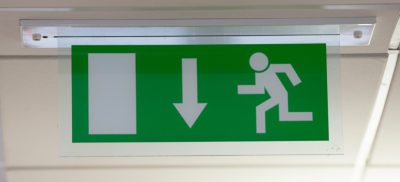We have been running a series of workshops on the new amendments (2013 & 2017) to I.S. 3217, the Irish Standard on Emergency Lighting. The workshops sparked some very interesting discussions about the practical applications of the Standard ‘in the field’. Here are just a few of the questions that we answered..
Q 1: If a door in a room requires an exit sign, then does it also require a luminaire to light the threshold of the door?
 Answer: Emergency Exit doors are a point of emphasis which require illumination from a luminaire normally mounted within 2m. Emergency exit doors are doors on the escape route OR doors deemed to require an exit sign (like the door above). So in summary, if the door needs a sign, it needs a luminaire and a sign. One solution would be to source a product that is both a luminaire and a sign (such as Ansell 5W Harrier Blade Exit).
Answer: Emergency Exit doors are a point of emphasis which require illumination from a luminaire normally mounted within 2m. Emergency exit doors are doors on the escape route OR doors deemed to require an exit sign (like the door above). So in summary, if the door needs a sign, it needs a luminaire and a sign. One solution would be to source a product that is both a luminaire and a sign (such as Ansell 5W Harrier Blade Exit).
Q 2: Can I use Type 1 and Type 2 exit signs in the one installation?
Answer: I.S. 3217 recommends that Type 1 and Type 2 are not mixed, but without explicitly stating it. However this refers to new designs, it may not be possible to avoid mixing in a partial extension or refurbishment.
Q 2: Our Company is doing an LED retro-fit of normal fluorescent lighting and for each converted emergency light they put in an LED emergency spot. Is this considered a new design and do we need to apply latest standards?
 Answer: Replacement of obsolete fittings is not considered a new design so long as the new replacement fitting enhances the performance. So, if the LED emergency spot gives a better output than the fluorescent conversion, then it is not considered a new installation and a design cert is not required.
Answer: Replacement of obsolete fittings is not considered a new design so long as the new replacement fitting enhances the performance. So, if the LED emergency spot gives a better output than the fluorescent conversion, then it is not considered a new installation and a design cert is not required.
